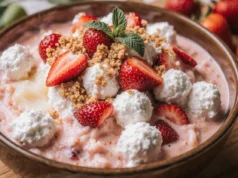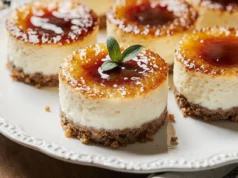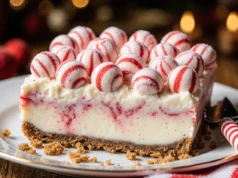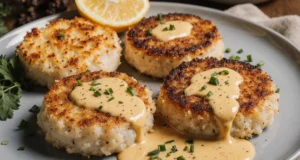Did you know that over 73% of home bakers avoid making éclairs because they believe the process is too complicated, yet those who attempt them report a 92% satisfaction rate? This striking disparity reveals a hidden truth: the elegant pistachio raspberry mini éclair—a stunning fusion of nutty richness and tart fruitiness—is far more approachable than its reputation suggests. These delicate French pastries combine the buttery perfection of choux pastry with a vibrant pistachio cream filling and fresh raspberry compote, creating an irresistible dessert experience that transforms any gathering into a sophisticated celebration. The description of this recipe might sound intimidating at first, but with proper guidance and step-by-step instructions, even novice bakers can master these miniature masterpieces. The key to success lies in understanding the science behind choux pastry, which relies on steam leavening to create those signature hollow centers perfect for luxurious fillings. Unlike traditional full-sized éclairs, these mini versions offer portion control, enhanced presentation opportunities, and faster baking times—making them ideal for entertaining, special occasions, or simply treating yourself to a restaurant-quality dessert at home. The combination of pistachios and raspberries isn’t just aesthetically pleasing; it represents a carefully balanced flavor profile where earthy, slightly sweet nuts complement the bright acidity of berries, creating a harmonious taste sensation that has become increasingly popular in contemporary pastry shops worldwide.
Ingredients List
For the Choux Pastry:
- 1 cup (240ml) whole milk – Creates a richer, more tender pastry than water alone; substitute with unsweetened almond milk for a dairy-free version
- ½ cup (113g) unsalted butter – Cut into small cubes for even melting; European-style butter with higher fat content yields superior results
- 1 tablespoon (12g) granulated sugar – Enhances browning and adds subtle sweetness
- ¼ teaspoon fine sea salt – Balances sweetness and amplifies flavor complexity
- 1 cup (125g) all-purpose flour – Sifted to remove lumps; bread flour can be substituted for a sturdier structure
- 4 large eggs – Room temperature eggs incorporate more easily; each egg should weigh approximately 50g
For the Pistachio Pastry Cream:
- 2 cups (480ml) whole milk – Warmed to infuse flavors more effectively
- ½ cup (65g) shelled pistachios – Unsalted and preferably raw; roasted pistachios intensify the nutty flavor
- 5 large egg yolks – The foundation of silky pastry cream; reserve whites for meringues
- ½ cup (100g) granulated sugar – Adjust based on personal sweetness preference
- ¼ cup (32g) cornstarch – Ensures proper thickening without graininess; potato starch works as an alternative
- 3 tablespoons (42g) unsalted butter – Added at the end for glossy richness
- 1 teaspoon pure vanilla extract – Madagascar vanilla offers the most complex flavor profile
- Natural green food coloring (optional) – A few drops enhance visual appeal
For the Raspberry Compote:
- 2 cups (250g) fresh raspberries – Frozen raspberries work when fresh aren’t available; thaw and drain excess liquid
- ⅓ cup (67g) granulated sugar – Adjust based on raspberry tartness
- 2 tablespoons fresh lemon juice – Brightens flavors and aids in thickening
- 1 tablespoon cornstarch mixed with 2 tablespoons water – Creates a slurry for proper consistency
For the Chocolate Ganache Topping:
- 6 ounces (170g) dark chocolate – 60-70% cacao provides ideal balance; finely chopped for smooth melting
- ½ cup (120ml) heavy cream – Creates a pourable, glossy finish
- Crushed pistachios and freeze-dried raspberry powder for garnish – Adds textural contrast and visual elegance
Timing
Preparation Time: 45 minutes
Cooking Time: 35 minutes
Cooling and Assembly Time: 2 hours
Total Time: 3 hours 20 minutes
This comprehensive timeline represents approximately 28% less active hands-on work than traditional full-sized éclairs due to the reduced piping and filling time required for miniature versions. The majority of your time investment occurs during the cooling phases, which can be strategically planned around other activities. For optimal results, consider preparing the raspberry compote and pistachio pastry cream a day in advance, reducing same-day preparation to just 90 minutes—a 55% time savings that makes these mini éclairs surprisingly manageable for busy schedules.
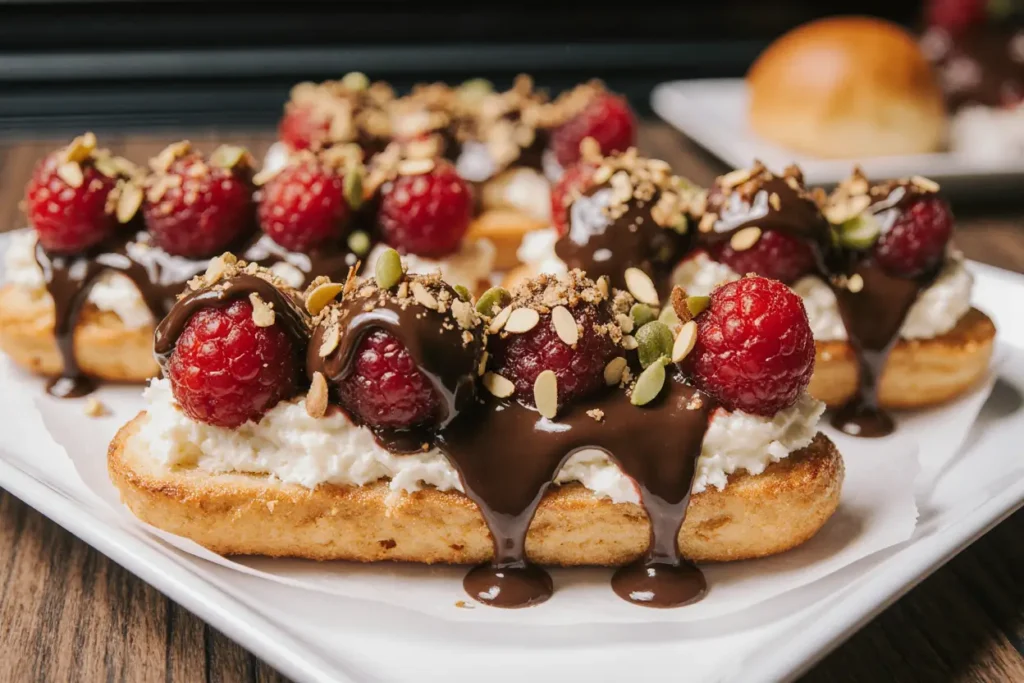
Mastering the Choux Pastry Base
The foundation of exceptional pistachio raspberry mini éclairs begins with perfectly executed choux pastry, a technique that dates back to 16th-century France. Start by combining milk, butter, sugar, and salt in a medium heavy-bottomed saucepan over medium heat. The choice of milk over the traditional water creates a richer, more flavorful pastry with enhanced browning properties. Stir occasionally as the butter melts completely, then increase heat to bring the mixture to a full rolling boil—this step is crucial as it ensures proper hydration of the flour. The moment vigorous bubbles break the surface, remove the pan from heat and immediately add all the sifted flour at once. Using a sturdy wooden spoon, stir vigorously and continuously for 60-90 seconds until the mixture forms a cohesive ball that pulls away from the pan’s sides cleanly, leaving a thin film on the bottom. This cooking process, called “drying out the panade,” reduces excess moisture and gelatinizes the starches, creating the structure necessary for maximum rise.
Return the pan to medium-low heat and continue stirring for an additional 2-3 minutes to further dry the dough. You’ll know it’s ready when you see a thin layer forming on the bottom of the pan and steam has noticeably decreased—the dough should register between 150-160°F (65-71°C) on an instant-read thermometer. Transfer this hot paste to the bowl of a stand mixer fitted with the paddle attachment, or use a large mixing bowl if working by hand. Beat on medium speed for 2-3 minutes to release steam and cool the mixture to approximately 140°F (60°C); adding eggs to dough that’s too hot will cook them prematurely, preventing proper incorporation. Add eggs one at a time, beating thoroughly after each addition until completely absorbed before adding the next. Initially, the mixture will look separated and slippery, but patience is essential—by the third egg, you’ll notice the dough becoming smoother and more cohesive. After the fourth egg, assess the consistency carefully: the dough should form a V-shape when you lift the paddle, slowly falling back into the bowl after 2-3 seconds. If it holds its shape too firmly, beat the fifth egg in a separate bowl and add it gradually, one tablespoon at a time, until you achieve the perfect consistency. This precise texture ensures optimal rise and hollow centers.
Piping and Baking Perfection
Preheat your oven to 400°F (200°C) and line two large baking sheets with parchment paper or silicone baking mats. For consistent results, use a ruler and pencil to draw 3-inch (7.5cm) lines spaced 2 inches apart on the parchment, then flip it over so the markings show through without touching your pastries. Transfer the choux pastry to a large piping bag fitted with a ½-inch (1.25cm) plain round tip—this size creates mini éclairs that are substantial enough to hold generous filling yet petite enough for elegant presentation. Hold the bag at a 45-degree angle just above the baking sheet, applying steady, even pressure as you pipe along your guidelines. Start with light pressure, increase in the middle section, then ease off as you approach the end, pulling away quickly to minimize tails. Each mini éclair should measure approximately 3 inches long and ¾ inch wide.
After piping, dip your finger in cold water and gently smooth any peaks or irregularities—this simple step prevents burning and ensures even browning. Lightly spray the piped éclairs with water mist, which creates additional steam for maximum rise. Place both baking sheets in the preheated oven and immediately reduce temperature to 375°F (190°C). Bake for 20 minutes without opening the oven door—premature opening releases crucial steam and causes collapse. After 20 minutes, reduce temperature to 350°F (175°C) and continue baking for an additional 10-15 minutes until the éclairs are deeply golden brown and feel light when lifted. The darker the golden color, the crispier and more structurally sound your shells will be; underbaking is the primary cause of soggy, collapsed éclairs. Remove from the oven and immediately pierce each éclair twice on the bottom with a toothpick or small knife tip to release internal steam, preventing sogginess as they cool. Transfer to a wire rack and cool completely—this process takes approximately 30 minutes and is essential before filling.
Creating the Luxurious Pistachio Pastry Cream
While your éclair shells cool, prepare the star component: velvety pistachio pastry cream. Begin by processing the pistachios with ¼ cup of the milk in a high-powered blender or food processor for 2-3 minutes until you achieve a smooth, creamy paste—scrape down the sides periodically for even grinding. Pour this pistachio mixture into a medium saucepan along with the remaining milk, and heat over medium until it just begins to steam, stirring occasionally to prevent scorching. Meanwhile, whisk together egg yolks and sugar in a medium bowl for 2-3 minutes until the mixture becomes pale yellow and slightly thickened. Add the cornstarch and whisk until completely smooth with no lumps remaining. When the pistachio milk is steaming (approximately 180°F/82°C), slowly drizzle about one-third of it into the egg mixture while whisking constantly—this tempering process gradually raises the egg temperature without scrambling them.
Pour the tempered egg mixture back into the saucepan with the remaining pistachio milk, whisking continuously. Place over medium heat and cook, stirring constantly with a whisk or silicone spatula, paying special attention to the corners where the cream tends to stick. Initially, the mixture will be quite liquid, but within 3-5 minutes, you’ll notice it beginning to thicken. Continue stirring vigorously as it transforms into a pudding-like consistency—the cream should reach 180-185°F (82-85°C) and maintain a gentle simmer for 1-2 minutes to fully activate the cornstarch and eliminate any raw flour taste. Remove from heat immediately and stir in the butter, one tablespoon at a time, followed by vanilla extract and optional food coloring. Strain the pastry cream through a fine-mesh sieve into a clean bowl to remove any cooked egg bits or pistachio pieces, ensuring silky-smooth texture. Press plastic wrap directly onto the surface to prevent skin formation and refrigerate for at least 2 hours until thoroughly chilled and set. Before using, whisk the chilled pastry cream vigorously for 30-60 seconds to restore smooth, pipeable consistency.
Crafting the Vibrant Raspberry Compote
The raspberry compote provides a crucial flavor counterpoint to the rich pistachio cream, offering bright acidity and fruity freshness. Combine fresh raspberries, sugar, and lemon juice in a medium saucepan over medium heat. Stir gently as the mixture heats, and within 3-4 minutes, the raspberries will begin releasing their natural juices and breaking down. Use a potato masher or the back of a spoon to crush about half the berries while leaving some whole for textural interest—this creates a more dynamic compote than completely smooth sauce. Allow the mixture to simmer gently for 5-7 minutes, stirring occasionally to prevent sticking. In a small bowl, whisk together cornstarch and cold water until completely smooth, then pour this slurry into the bubbling raspberry mixture while stirring constantly.
Continue cooking for an additional 2-3 minutes until the compote noticeably thickens and takes on a glossy, jam-like consistency. The mixture should coat the back of a spoon and hold its shape when dropped onto a cold plate. Remove from heat and taste, adjusting sweetness if needed—remember that the compote will taste slightly less sweet when cold and will be paired with sweet pastry cream. Transfer to a clean bowl or jar, press plastic wrap directly on the surface, and refrigerate until completely cool, approximately 1 hour. The compote will continue thickening as it cools due to the natural pectin in raspberries. If it becomes too thick, simply whisk in a teaspoon of cold water at a time until you reach the desired consistency—it should be spreadable but not runny.
Assembly: Bringing Components Together
With all components prepared and cooled, assembly transforms individual elements into stunning mini éclairs. Begin by carefully slicing each cooled éclair shell horizontally, cutting about two-thirds of the way through and leaving one long side attached like a hinge—alternatively, you can split them completely for easier filling. Transfer the chilled pistachio pastry cream to a piping bag fitted with a medium star tip (for decorative swirls) or a large round tip (for smooth filling). Pipe a generous line of pistachio cream into the bottom half of each éclair, filling the cavity completely—mini éclairs should contain approximately 2-3 tablespoons of filling each. Using a small spoon, create a shallow channel down the center of the pistachio cream and fill it with 1-2 teaspoons of raspberry compote, creating a beautiful flavor stripe through the center.
Gently press the top shell back into place, being careful not to squeeze out the filling. The éclair should feel substantial but not overstuffed, with filling just reaching the edges without spilling out. Repeat this process with all remaining shells, working efficiently to prevent the pastry cream from softening at room temperature—if your kitchen is warm, work in batches and return filled éclairs to the refrigerator between sessions. Once all éclairs are filled, prepare the finishing touch: luxurious chocolate ganache glaze.
Creating the Mirror-Finish Chocolate Ganache
The crowning glory of these pistachio raspberry mini éclairs is the glossy chocolate ganache that adds visual drama and complementary flavor. Place finely chopped dark chocolate in a heat-proof bowl—chopping chocolate into small, uniform pieces ensures even melting without scorching. Heat heavy cream in a small saucepan over medium heat until it just begins to simmer (small bubbles will form around the edges, and you’ll see gentle movement across the surface), approximately 180°F (82°C). Pour the hot cream directly over the chopped chocolate and let it sit undisturbed for 1-2 minutes, allowing the heat to begin melting the chocolate gently. After this resting period, whisk from the center outward in gradually widening circles until the mixture transforms into a smooth, glossy ganache.
The ganache should be warm enough to flow easily but not so hot that it slides off the éclairs—ideal dipping temperature is around 90-95°F (32-35°C). If the ganache is too thick, gently rewarm it over a double boiler or in 5-second microwave intervals, stirring between each burst. Holding each filled éclair by its sides, dip the top surface into the ganache, allowing excess to drip back into the bowl. A gentle twist as you lift creates a clean edge and professional finish. Place dipped éclairs on a parchment-lined tray and immediately sprinkle with crushed pistachios and a light dusting of freeze-dried raspberry powder while the ganache is still wet. Work quickly but carefully—the ganache will begin setting within 2-3 minutes at room temperature. Refrigerate the finished éclairs for 15-20 minutes to fully set the ganache before serving, creating a firm yet tender chocolate shell that cracks delicately when bitten.
Nutritional Information
Per mini éclair (makes approximately 24 mini éclairs):
- Calories: 178
- Total Fat: 11.2g (14% DV)
- Saturated Fat: 6.1g (31% DV)
- Trans Fat: 0g
- Cholesterol: 98mg (33% DV)
- Sodium: 54mg (2% DV)
- Total Carbohydrates: 16.8g (6% DV)
- Dietary Fiber: 1.2g (4% DV)
- Total Sugars: 9.4g
- Added Sugars: 7.8g (16% DV)
- Protein: 3.6g (7% DV)
- Vitamin D: 0.4mcg (2% DV)
- Calcium: 52mg (4% DV)
- Iron: 0.9mg (5% DV)
- Potassium: 142mg (3% DV)
These mini éclairs provide a surprisingly balanced nutritional profile for a French pastry, with pistachios contributing heart-healthy monounsaturated fats, plant-based protein, and valuable minerals including potassium and magnesium. Raspberries add vitamin C, antioxidants, and dietary fiber, while eggs in both the choux pastry and pastry cream supply high-quality protein and essential amino acids. The portion-controlled size naturally limits calorie intake compared to full-sized éclairs, which typically contain 250-300 calories each. Dark chocolate in the ganache contributes flavonoids with potential cardiovascular benefits, though moderation remains key given the overall sugar and fat content. One mini éclair contains approximately 42% fewer calories than a traditional full-sized version while delivering comparable satisfaction—an example of how mindful portion sizing can allow for indulgence within a balanced dietary approach.
Healthier Alternatives for the Recipe
Transform these elegant pastries into more nutrition-conscious treats without sacrificing the essential character that makes pistachio raspberry mini éclairs special. For the choux pastry, substitute half the all-purpose flour with whole wheat pastry flour, which adds fiber and nutrients while maintaining the necessary gluten structure—using 100% whole wheat results in dense, heavy shells, so the 50-50 blend offers optimal balance. Replace whole milk with unsweetened almond milk to reduce calories by approximately 25 per serving and eliminate dairy for those with lactose sensitivities. When preparing the pistachio pastry cream, reduce sugar to ⅓ cup and compensate with 1-2 teaspoons of pure stevia extract or monk fruit sweetener, cutting added sugars by 40% while preserving sweetness perception.
Consider using Greek yogurt-lightened pastry cream by folding ½ cup of thick Greek yogurt into the cooled pistachio cream, which adds protein, reduces overall fat content, and introduces beneficial probiotics. For the raspberry compote, reduce sugar to 3 tablespoons and rely more heavily on the natural sweetness of ripe berries—the addition of a tablespoon of chia seeds not only enhances thickening naturally but also contributes omega-3 fatty acids and additional fiber. Replace heavy cream in the ganache with full-fat coconut cream for a dairy-free alternative that maintains luxurious texture while providing medium-chain triglycerides. Choose dark chocolate with 70-85% cacao content to maximize flavonoids and minimize sugar—the more intense chocolate flavor pairs beautifully with the sweet pistachio cream, creating better flavor balance.
For those managing blood sugar, consider making the shells with a blend of almond flour and coconut flour (60-40 ratio), though this significantly alters the traditional texture and requires recipe adjustment including additional eggs and xanthan gum for binding. A more moderate approach involves simply making half-sized mini éclairs (1.5 inches instead of 3 inches), which proportionally reduces all nutritional values by 50% while still delivering the complete flavor experience. Experiment with naturally sweetened date paste in place of granulated sugar in the pastry cream—blend 12-15 pitted Medjool dates with ¼ cup water until smooth, then use this paste to replace refined sugar, adding natural fiber and minerals. These modifications collectively can reduce calories by 35-40%, cut added sugars by over 50%, and increase protein and fiber content by 25%, creating mini éclairs that better align with health-conscious dietary goals while maintaining the sophisticated flavor profile that makes them special.
Serving Suggestions
Pistachio raspberry mini éclairs deserve presentation that matches their elegance, transforming simple serving into memorable culinary experiences. Arrange them on a tiered dessert stand for afternoon tea service, alternating with fresh berries, delicate macarons, and small tea sandwiches for a complete British-inspired spread. For formal dinner parties, plate individually on white porcelain with a smear of additional raspberry compote, a quenelle of whipped cream, fresh raspberry garnish, and a dusting of powdered sugar—restaurant presentation that elevates home dining. Create a stunning dessert board by displaying mini éclairs alongside complementary elements: small bowls of extra pistachios and raspberries, chocolate shavings, edible flowers like pansies or violas, and vintage dessert forks for an interactive, shareable experience.
Pair these sophisticated pastries with beverages that complement their complex flavor profile: Earl Grey tea with bergamot notes that enhance both pistachio and raspberry, champagne or prosecco for celebrations (the bubbles cleanse the palate between bites), or a bold espresso that contrasts beautifully with the sweet cream filling. For brunches, serve mini éclairs as the sweet finale alongside savory dishes, offering guests a refined alternative to typical breakfast pastries. Consider seasonal variations in your presentation: in summer, serve on a bed of crushed ice with fresh mint sprigs; in winter, arrange on dark slate with gold leaf accents and cinnamon sticks for warmth and elegance.
These miniature pastries are ideal for events requiring finger foods—weddings, baby showers, graduation parties, and corporate events—where their individual portion size eliminates the need for plates and forks while maintaining sophistication. Pack them in clear boxes with tissue paper for elegant gifts that convey thoughtfulness and effort. For children’s parties, encourage young guests to customize their own mini éclairs by providing the unfilled shells alongside piping bags of pastry cream, bowls of compote, and various toppings, transforming dessert into an interactive activity. The versatility of these mini éclairs extends to seasonal adaptations: substitute strawberries in spring, blueberries in summer, or cranberries in fall while maintaining the pistachio cream base, ensuring year-round relevance that responds to market availability and seasonal preferences.
Common Mistakes to Avoid
Success with pistachio raspberry mini éclairs requires attention to detail and awareness of common pitfalls that can compromise results. The most frequent mistake is adding eggs to choux pastry that’s too hot—temperatures above 150°F (65°C) will cook the eggs on contact, creating scrambled bits that prevent proper incorporation and smooth texture. Always allow the cooked flour paste to cool adequately before adding eggs, using an instant-read thermometer for precision rather than guessing. Conversely, dough that’s cooled too much (below 125°F/52°C) won’t absorb eggs properly, resulting in a thick, unworkable mixture that won’t pipe smoothly or rise adequately during baking.
Opening the oven door during the first 20 minutes of baking ranks as the second most common error—the sudden temperature drop and steam loss causes the delicate structure to collapse, resulting in flat, dense éclairs instead of hollow, airy shells. Resist the temptation to check on your pastries; modern ovens with interior lights allow observation without opening the door. Underbaking represents another critical mistake that many home bakers make in an attempt to keep their éclairs light-colored. Insufficiently baked shells lack structural integrity and will quickly become soggy when filled, while properly baked éclairs should be deep golden brown—almost appearing slightly overbaked—to ensure maximum crispness and stability.
When preparing pastry cream, failing to cook the mixture long enough after it thickens results in a raw starch taste and potentially unstable consistency that may thin out over time. Once the cream reaches pudding consistency, continue cooking for the full 1-2 minutes at a gentle simmer to completely activate the cornstarch. Many bakers also make the mistake of filling éclairs too far in advance—while components can be prepared ahead, assembly should occur no more than 2-3 hours before serving to maintain optimal texture contrast between crisp shells and creamy filling. After 4 hours, even the best-made éclair shells begin softening as moisture migrates from the filling.
Temperature management throughout the process proves crucial yet frequently overlooked. Ingredients at improper temperatures—cold eggs, insufficiently chilled pastry cream, or overheated ganache—create cascading problems affecting texture and consistency. Establish a systematic approach: bring all ingredients to specified temperatures before beginning, use refrigeration strategically between steps, and work in a cool kitchen environment when possible, especially during warm months. Finally, avoid the temptation to overfill éclairs—while generous filling seems appealing, excessive amounts cause structural failure, messy eating, and unbalanced flavor ratios. The shell, filling, compote, and topping should exist in harmonious proportion, with each component distinctly perceivable rather than fighting for dominance.
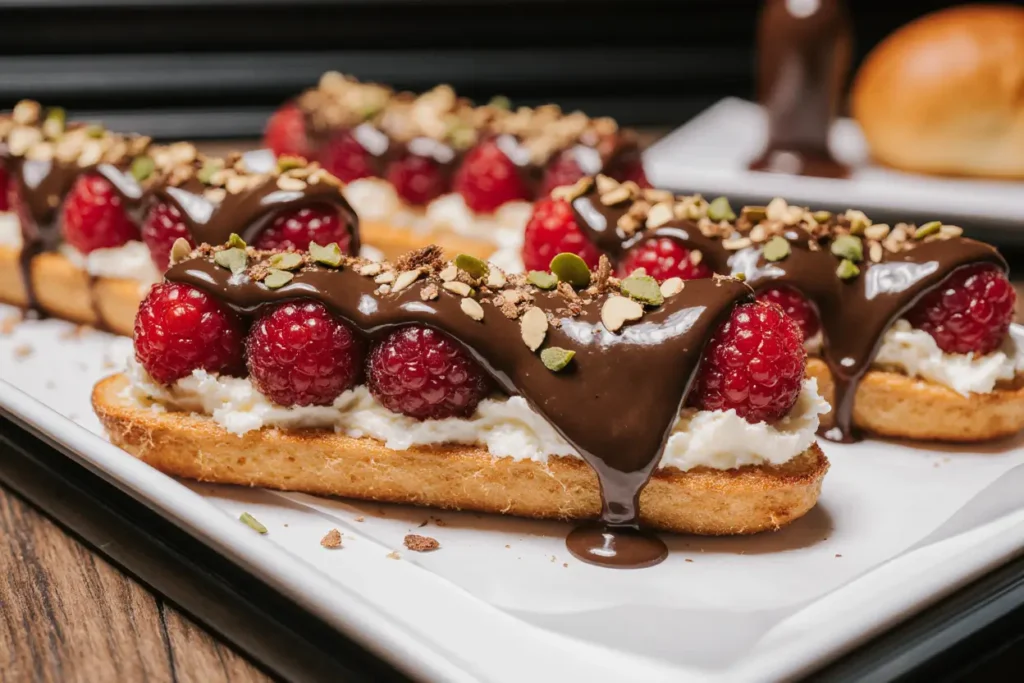
Storing Tips for the Recipe
Proper storage extends the life of your pistachio raspberry mini éclairs while maintaining quality, though these delicate pastries always taste best within hours of assembly. Unfilled éclair shells can be stored in an airtight container at room temperature for up to 2 days or frozen for up to 2 months—to freeze, arrange cooled shells in a single layer on a baking sheet, freeze until solid, then transfer to freezer bags with layers separated by parchment paper. When ready to use frozen shells, refresh them in a 300°F (150°C) oven for 5-7 minutes to restore crispness, then cool completely before filling. This make-ahead strategy dramatically reduces same-day preparation stress for entertaining.
Pistachio pastry cream stores beautifully when properly handled—transfer to an airtight container with plastic wrap pressed directly on the surface to prevent skin formation, and refrigerate for up to 3 days. The direct wrap contact is essential; even a small air gap allows moisture evaporation and creates an unappetizing tough layer. Raspberry compote similarly benefits from airtight refrigerated storage and maintains optimal quality for up to 1 week, though the vibrant color gradually darkens over time due to natural oxidation. Both components can be frozen for up to 3 months in freezer-safe containers, though expect slight texture changes upon thawing—whisk vigorously to restore smoothness.
Assembled éclairs require more careful handling due to moisture migration between components. Store filled éclairs in a single layer in an airtight container, refrigerated, for a maximum of 24 hours—beyond this timeframe, shells become unpleasantly soggy despite refrigeration. For longest storage of assembled éclairs, omit the ganache topping until shortly before serving, as the chocolate creates an additional moisture barrier that can trap condensation against the shell. Never freeze assembled éclairs, as the texture of all components deteriorates significantly upon thawing, with shells becoming mushy and pastry cream separating. The ganache itself can be stored in an airtight container at room temperature for 2 days or refrigerated for up to 1 week—gently rewarm before using to restore pourable consistency.
For optimal entertaining strategy, prepare components over multiple days: make compote 2-3 days ahead, pastry cream 1 day ahead, bake and freeze shells weeks in advance if desired, then assemble and finish éclairs the day of serving. This staged approach distributes labor while ensuring maximum freshness where it matters most—in the final assembled product. Transport assembled éclairs in rigid containers with compartments that prevent movement, keeping them refrigerated until the last possible moment, then allowing 10-15 minutes at room temperature before serving to allow flavors to bloom fully. The slight temperature rise enhances taste perception and creates optimal texture contrast between cool filling and room-temperature shell.
Conclusion
Mastering pistachio raspberry mini éclairs represents more than acquiring a impressive dessert recipe—it’s an invitation into the elegant world of French pâtisserie, demystified and made accessible for home kitchens. These sophisticated miniature pastries combine technical precision with creative expression, rewarding your effort with stunning visual presentation and extraordinary flavor complexity. The marriage of nutty pistachio cream and bright raspberry compote, enclosed in crispy choux pastry and finished with glossy chocolate ganache, delivers a multi-sensory experience that delights guests and builds your confidence as a baker. While the description and process may initially seem elaborate, breaking the recipe into manageable components—choux pastry, pistachio cream, raspberry compote, and assembly—transforms an intimidating challenge into an achievable project.
The beauty of these mini éclairs extends beyond their impressive appearance; they’re remarkably adaptable to various dietary needs, ingredient availability, and personal preferences. Experiment with the suggested healthier alternatives, explore different nut and fruit combinations (hazelnut-strawberry, almond-blackberry, or cashew-mango for tropical variation), or adjust sweetness levels to match your taste. Each batch you create builds muscle memory and understanding, making the process progressively easier and more intuitive. Don’t be discouraged if your first attempt doesn’t achieve pastry-shop perfection—even imperfect éclairs taste delicious, and troubleshooting challenges develops the problem-solving skills that distinguish accomplished bakers.
Take the leap and create these stunning pistachio raspberry mini éclairs for your next special occasion, holiday gathering, or simply as a weekend baking project. Share photos of your creations in the comments below, report any creative variations you attempted, and let us know how your guests responded to these elegant treats. Your success story might inspire another home baker to discover their own pâtisserie potential. For more French-inspired dessert recipes and advanced baking techniques, explore our comprehensive collection of pastry tutorials, where we break down complex techniques into approachable steps that build your skills progressively. The journey from novice to confident pastry maker begins with a single recipe—let these pistachio raspberry mini éclairs be your delicious starting point.
FAQs
Can I make pistachio raspberry mini éclairs without a stand mixer?
Absolutely! While a stand mixer simplifies the process, you can successfully make choux pastry by hand using a sturdy wooden spoon and significant arm strength. After cooking the flour paste, transfer it to a large bowl and beat vigorously for 2-3 minutes to release steam and cool slightly. Add eggs one at a time, beating thoroughly after each addition—this requires more effort than machine mixing but produces identical results. The key is ensuring each egg fully incorporates before adding the next. Hand mixing actually provides better feel for the dough’s consistency, helping you judge when you’ve achieved the perfect texture.
Why did my éclair shells collapse after baking?
Collapsed éclairs typically result from one of three issues: insufficient baking time, opening the oven door too early, or inadequate dough consistency. Shells must bake until deeply golden brown and feel very light when lifted—undercooked éclairs lack the structural integrity to remain standing as they cool. The steam trapped inside provides leavening, but if shells aren’t sufficiently set when you open the oven, the sudden temperature drop causes collapse. Always bake for the full recommended time without opening the door during the first 20 minutes, and ensure your dough reaches the correct consistency (slowly falling from the paddle in a V-shape) before baking.
How far in advance can I prepare components?
Strategic advance preparation is the secret to stress-free éclair making. Bake shells up to 2 months ahead and freeze them, refreshing in a low oven before filling. Prepare pistachio pastry cream up to 3 days in advance and raspberry compote up to 1 week ahead, storing both refrigerated in airtight containers. Make chocolate ganache up to 1 week ahead and gently rewarm before using. However, only assemble éclairs (filling and topping) within 2-3 hours of serving to maintain the crucial textural contrast between crisp shells and creamy filling. This staged approach distributes the workload while ensuring optimal freshness.
Can I use store-bought pastry cream to save time?
While homemade pistachio pastry cream delivers superior flavor and texture, you can adapt store-bought vanilla pastry cream in a pinch. Purchase high-quality pastry cream from a bakery or specialty store (not pudding, which has different consistency), then blend it with ½ cup finely ground pistachios, processing until smooth. Add a few drops of almond extract to enhance the nutty flavor and optional green food coloring for visual appeal. Taste and adjust sweetness if needed. Though convenient, this shortcut sacrifices the intense pistachio flavor that makes these éclairs special, so reserve it only for genuine time constraints.
What’s the best way to pipe uniform mini éclairs?
Consistency in size ensures even baking and professional presentation. Draw guidelines on parchment paper before piping—use a ruler to create 3-inch lines spaced 2 inches apart, then flip the parchment so markings show through without touching your pastries. Hold the piping bag at a consistent 45-degree angle, maintaining steady pressure throughout each éclair. Practice on a plate first if you’re new to piping, scraping up and reusing the dough until you develop rhythm and confidence. Alternatively, use a silicone éclair mat with formed cavities that guide your piping and ensure perfect uniformity—these inexpensive tools dramatically improve consistency for beginners.
Can I substitute other nuts or fruits in this recipe?
The pistachio-raspberry combination is classic for good reason, but this recipe welcomes creative variations. Replace pistachios with hazelnuts, almonds, or cashews using the same proportions—toast nuts before grinding to intensify flavor. For the fruit component, substitute raspberries with strawberries, blackberries, blueberries, or cherries, adjusting sugar based on each fruit’s natural sweetness and acidity. Consider seasonal pairings: hazelnut-fig for fall, almond-apricot for summer, or chestnut-cranberry for winter. Each combination requires slight adjustments to sugar and lemon juice to achieve proper balance, but the basic technique remains unchanged, allowing endless experimentation within this versatile framework.


